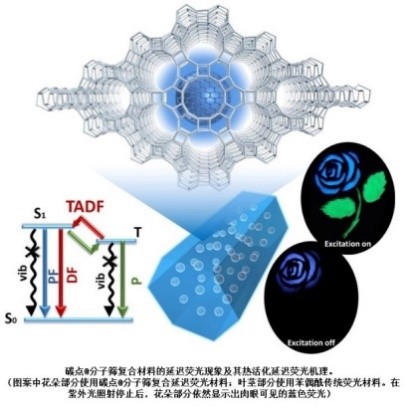By YU Jihong's Group
Materials with long-lived excited states, such as phosphorescence or thermally activated delayed fluorescence (TADF) materials, have aroused considerable interest for their important applications in optoelectronics, photocatalytic reactions, molecular imaging, and security aspects. To date, most of the TADF materials are limited to metal-organic complexes and organic molecules with lifetimes of several microseconds/milliseconds that are sensitive to oxygen. Prof. Yu and her coworkers reported a facial and general “dots-in-zeolites” strategy to in situ confine carbon dots (CDs) in zeolitic matrices during hydrothermal/solvothermal crystallization to generate high-efficient TADF materials with ultralong lifetimes. The resultant CDs@zeolite composites exhibit high quantum yields up to 52.14% and ultralong lifetimes up to 350 ms at ambient temperature and atmosphere. This intriguing TADF phenomenon is due to the fact that nanoconfined space of zeolites can efficiently stabilize the triplet states of CDs, thus enabling the reverse intersystem crossing process for TADF. Meanwhile, zeolite frameworks can also hinder oxygen quenching to present TADF behavior at air atmosphere. This design concept introduces a new perspective to develop materials with unique TADF performance and various novel delayed fluorescence–based applications. The representative work was published in the prestigious journal Science Advances in May 2017 (Sci. Adv., 2017. 3, e1603171).

Proposed TADF mechanism of CDs@zeolite composites and dual-responsive security protection application.
Blue flower petals made from carbon dots in a zeolite matrix fluoresce substantially longer than a green stem made from a benzyl dye.


